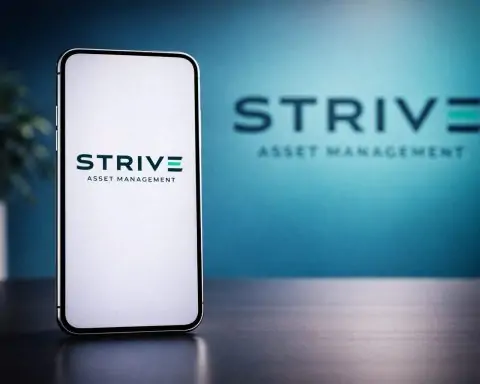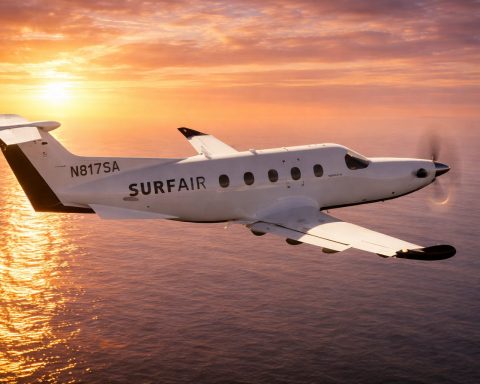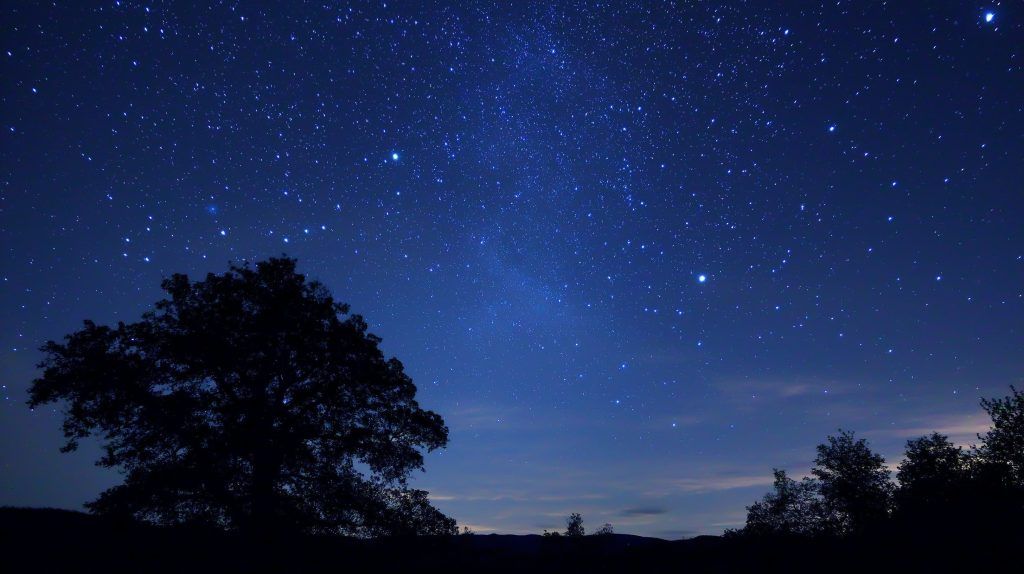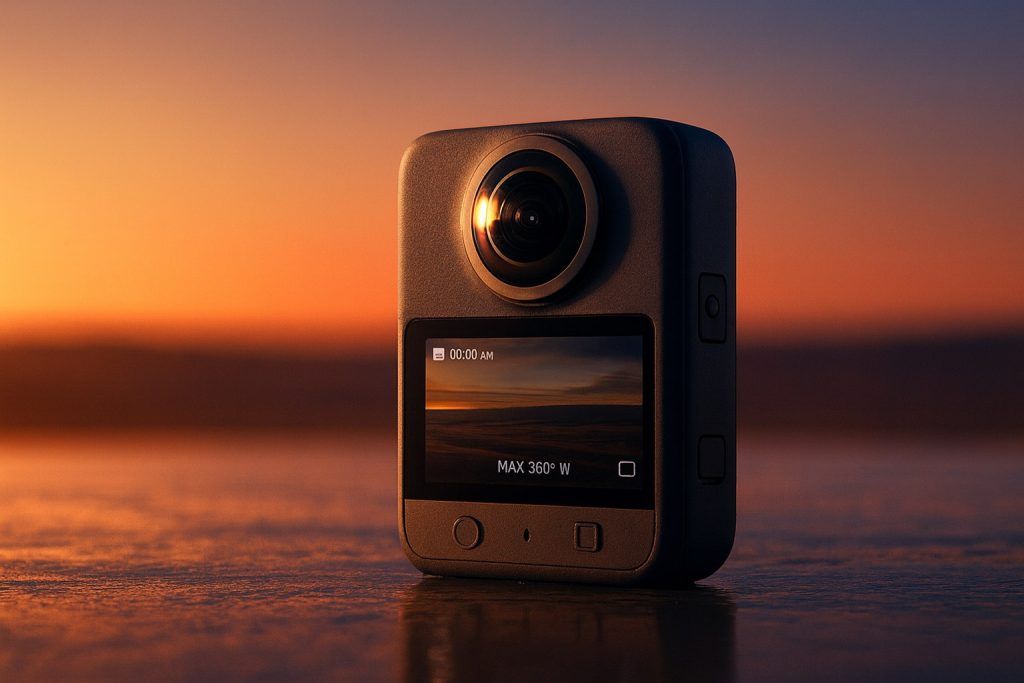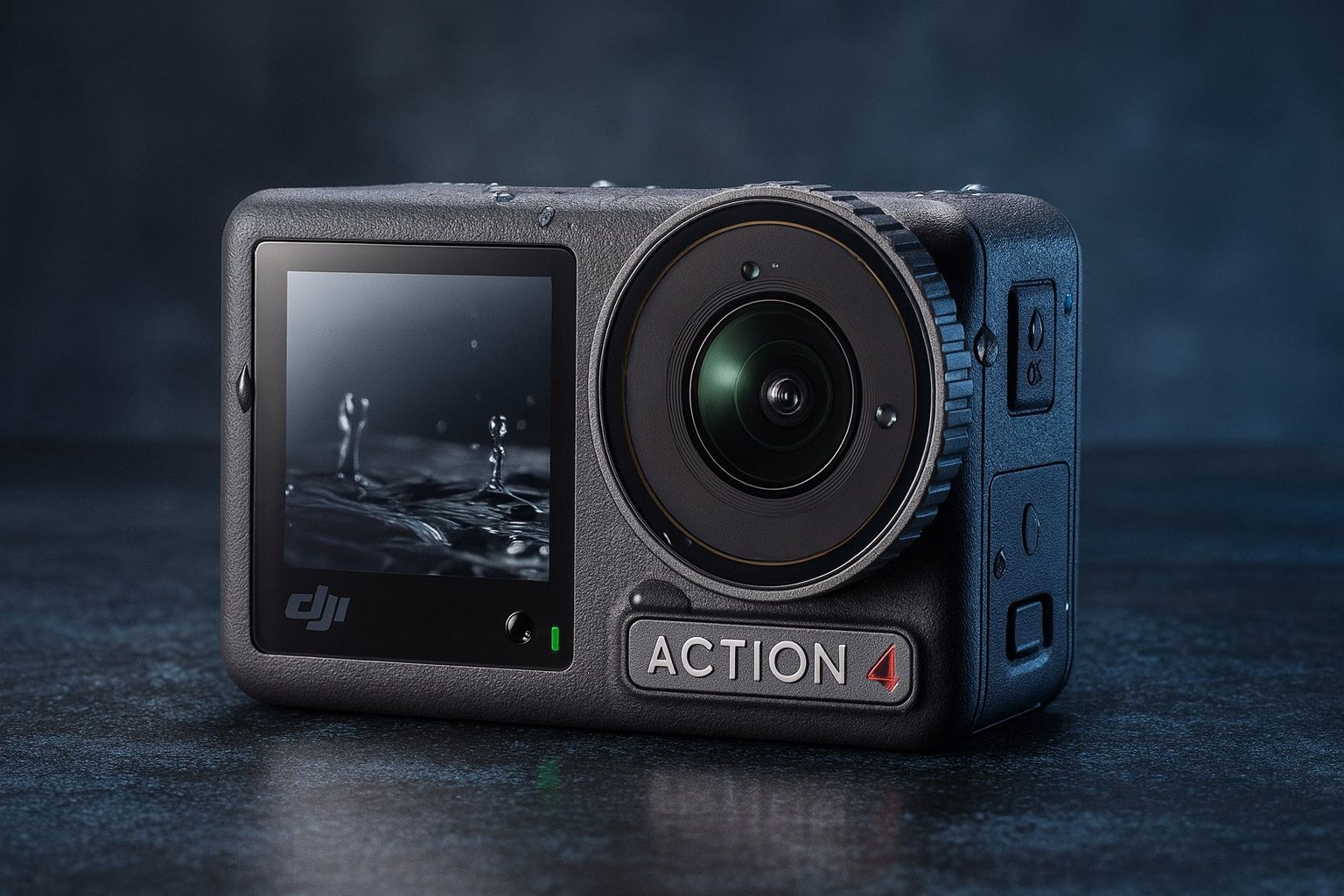- DJI Osmo Pocket 3 uses a 1-inch CMOS sensor on a 3-axis gimbal, records 4K up to 120fps, offers 10-bit D-Log M, weighs about 145g, and is priced around $519.
- GoPro Hero 13 Black, released in late 2024, shoots up to 5.3K at 60fps with a 1/1.9-inch sensor, supports interchangeable lenses (Ultra-Wide 177°, Macro, Anamorphic), features a built-in magnetic mounting system, and delivers about 1–1.5 hours of battery life with prices around $400–$429.
- DJI Osmo Action 5 Pro uses a 1/1.3-inch sensor co-engineered with Leica, records 4K up to 120fps (including 4:3 mode), delivers about 2 hours of battery life, features RockSteady 3.0 and HorizonSteady, and works with the DJI Mic 2 with a price around $349.
- Insta360 X5, launched April 2025, features dual 1/1.28-inch sensors for 8K 360 video at 30fps, has replaceable lenses, is waterproof to 15m, offers a 3-hour battery, and includes PureVideo AI Night mode and 72 MP 360 photos.
- Insta360 Ace Pro 2 is a single-lens action cam using a 1/1.3-inch sensor, can shoot up to 8K/30fps in capable scenes, adds a flip-up 180-degree rear screen, offers roughly 2 hours of battery life, uses a magnetic mounting system, and yields image quality close to the DJI Osmo Action 5.
- Sony ZV-1 II uses a 1-inch sensor with an 18–50mm equivalent f/1.8–4.0 lens, records 4K/30fps, features Real-Time Eye AF and Product Showcase, and has a fully articulating screen with stabilization based on lens and electronic methods rather than a gimbal.
- Sony ZV-E10 II uses a 26MP APS-C sensor, can shoot 4K/60fps with a 1.1× crop and 10-bit video, and lacks in-body image stabilization.
- Canon PowerShot V1, launched March 2025, centers on an 18×12 mm sensor around 22MP, pairs with a 16–50mm f/2.8–4.5 lens with built-in ND, includes a cooling fan, Dual Pixel CMOS AF II, 4K/60 (with crop) and 1080p/120, weighs 426 g, and is priced around $900–$1000.
- Budget options from Akaso and similar brands offer entry-level 4K/60 and basic stabilization around $100–$200, with limited waterproofing and image quality.
- Looking ahead to 2025–2026, the market expects GoPro Hero 14 with a new GP3 chip and Max 2 360 cam, plus DJI Osmo Action 6 or Osmo Nano, Insta360 X6 or Ace Pro 3, and potential ZV-2/ZV-1 III and Canon V2 variants.
In 2025, content creators and adventurers are spoiled for choice with powerful pocket-sized cameras. DJI’s latest Osmo 3 camera (the third-gen Osmo Pocket) is making waves with its big-sensor performance and gimbal stabilization, going head-to-head with action cam titans like GoPro’s Hero 13 Black and innovative 360° cams from Insta360. Add to that Sony’s and Canon’s compact vlogging contenders – plus newcomers pushing value and AI smarts – and it’s clear the portable camera showdown has never been more intense. Below, we compare all the major players (and peek at upcoming 2026 models) in image quality, stabilization, audio, AI features, portability, battery life, price, ecosystems, and overall usability for both aspiring vloggers and everyday users. Let’s see what makes each device stand out or fall short in this ultimate camera face-off.
DJI Osmo Pocket 3: Big Gimbal Upgrades in Your Pocket
DJI Osmo Pocket 3 – DJI’s “Osmo 3” – is a unique hybrid that blends an action cam and a vlogging camera into one tiny package. It packs a 1-inch CMOS sensor (much larger than typical action cams) on a 3-axis mechanical gimbal, delivering exceptionally smooth, leveled footage even when running or panning [1] [2]. That big sensor captures sharp, vibrant 4K video (up to 4K at 120 fps slow-motion) with impressive dynamic range and surprisingly good low-light performance [3]. In fact, the Pocket 3’s image quality rivals bigger cameras – reviewers praise it for “sharp, clear footage with excellent dynamic range” even in dim conditions [4]. It can also shoot 10-bit D-Log M flat color for pro-grade editing and offers creative tools like time-lapse and panorama modes.
Despite its tiny size, the Osmo Pocket 3 is feature-packed for creators. The built-in touchscreen now rotates for vertical shooting, letting you instantly switch to 9:16 portrait for TikToks or Instagram Reels [5]. DJI’s latest ActiveTrack 6.0 AI is onboard, which locks onto faces or subjects and smoothly tracks them with the gimbal – meaning you can walk and talk while the camera intelligently keeps you in frame [6] [7]. This AI tracking, combined with the gimbal, makes the Pocket 3 a “real superstar of stability” for handheld vlogging [8].
Audio is another strong point. The Pocket 3 has a built-in stereo mic and, importantly, native wireless mic support: it connects seamlessly to DJI’s Bluetooth microphone systems (like the DJI Mic 2) without any bulky receivers [9]. This means you can capture clear, wind-resistant audio from a lavalier or mini clip-on mic, a big plus for interviews or narrating travel vlogs. Portability is of course the Pocket’s raison d’être – at just ~145g, it slips into a pocket or small bag easily, ready to film on a whim [10]. Creators love that such a “compact, powerful, and loaded” camera is always on hand for spur-of-the-moment shots [11]. DJI also offers an Expansion Adapter and accessories (tripod mounts, control wheel, wide lenses, etc.), giving this tiny cam surprising flexibility [12].
Pros: Ultra-portable size, superb 3-axis stabilization, large 1″ sensor image quality, rotating touchscreen, excellent wireless audio support, and easy-to-use controls [13] [14]. Cons: It’s not waterproof or rugged – you must treat it more gently than a GoPro (no dunks in the pool without a case) [15]. Also, the contrast-detect autofocus can occasionally hunt focus, though face-detect mode mitigates this for typical vlogging [16] [17]. Finally, at $519 the Pocket 3 is pricey compared to basic action cams [18], but you’re paying for that unique gimbal and image quality. As one reviewer put it, the Osmo Pocket 3 is “the perfect hybrid between an action camera and a vlogging camera” – a versatile creative tool bridging the best of both worlds [19]. For solo content creators who want smooth, cinematic footage without lugging a larger setup, the Pocket 3 is hard to beat [20].
GoPro Hero 13 Black: The Action Cam King with New Tricks
GoPro’s Hero series has long been synonymous with action cameras, and the Hero 13 Black shows the company isn’t resting on its laurels. This latest GoPro (released late 2024) is the “first major update to GoPro’s flagship in many years”, bringing notable innovations while keeping the rugged GoPro formula intact [21]. Physically, the Hero 13 maintains GoPro’s familiar compact, rubberized build that’s waterproof to 33 ft (10 m) out of the box – you can literally surf, snowboard or sky-dive with it clipped on and not worry. It’s built like a little tank, ready for extreme conditions that might shatter other cams.
Under the hood, GoPro finally refreshed the camera’s capabilities. The Hero 13 can shoot up to 5.3K video (at 60 fps), yielding extremely detailed footage (great for high-res crops or large 4K displays). A headline addition is the new interchangeable lens mod system – the Hero 13’s lens cover twists off to swap in specialty lenses [22]. GoPro launched an Ultra-Wide 177° Lens, a Macro Close-up Lens, and even an Anamorphic Lens (for cinematic 2.35:1 videos with lens flares) [23]. This modularity makes the Hero 13 “considerably more versatile” than prior GoPros, effectively letting one camera adapt from fisheye POV shots to tight macro detail [24]. Keep in mind these lens mods are sold separately (and not cheap at ~$100 each), but you can buy only what you need. Another welcome change: GoPro added a built-in magnetic mounting system on the Hero 13 (complementing the traditional folding fingers mount) [25]. At long last, you can just snap the Hero 13 onto magnetic mounts or accessories – “finally catching up to competitors,” as WIRED notes [26].
Of course, the GoPro legacy features are here and improved. The HyperSmooth stabilization is now so advanced that even without a gimbal, your mountain bike or chest-mounted footage comes out buttery-smooth. Horizon Lock keeps your video level even if the camera rotates a full 360° (great for when your snowboarder GoPro goes upside-down mid-trick). The Hero 13 also supports 8x slow-motion and GP-Log for flat color. GoPro’s image quality in daylight is excellent – vibrant and punchy – but one drawback is GoPro stuck with essentially the same image sensor as previous models [27] [28]. This 1/1.9″ sensor is smaller than DJI’s and shows its age in low light, where the Hero 13 can’t match the clarity of rivals with bigger sensors [29] [30]. As one reviewer put it, the Hero 13’s sensor “shows its age when compared to the competition,” especially for night scenes [31]. In practice, this means GoPro footage may look noisier or softer in dim indoor or evening shots (though still usable if you avoid complete darkness).
Audio on the Hero 13 is decent – it has 3 mics with wind reduction – but for pro sound you’ll want either GoPro’s Media Mod (a wrap-around case with a shotgun mic and mic input) or to take advantage of its new Bluetooth audio support. The Hero 13 (like the Hero 12) can pair with Bluetooth wireless mics or even earbuds as microphones [32] [33], which is a handy trick for vlogging. In terms of battery life, GoPros have improved with the Enduro battery, but the Hero 13 still averages about 1 to 1.5 hours of continuous 4K recording in real-world use. This is noticeably shorter runtime than DJI’s Osmo Action (which can hit 2 hours) [34]. If you’re out for a full day of shooting, spare batteries or a power bank will be necessary.
The GoPro’s greatest strength is its massive ecosystem. The Hero 13 is backward-compatible with decades of GoPro mounts – from helmet straps to chest harnesses to suction cups – meaning you can mount it virtually anywhere. GoPro’s mobile app and “Quik” editing software make it easy to transfer and edit clips on the fly. For everyday users, the GoPro remains fairly easy to use: big touchscreen, one-button start, voice controls (“GoPro, start recording!”), and lots of automated modes. And if anything does go wrong, the camera is tough and has replaceable lens covers (or entire lens mods) and a strong warranty program.
Bottom line: The Hero 13 Black is a feature-rich action cam that still sets the bar for versatility and toughness. It’s the go-to for hardcore sports and travel thanks to its rugged design, excellent stabilization, and huge accessory ecosystem. However, against the new competition its weak spots are clear – shorter battery life and poorer low-light image quality than DJI’s latest [35] [36]. It’s also one of the pricier options (around $400–$429 retail) [37], and fully decking it out with lens mods and Media Mods can cost quite a bit more. Looking ahead, GoPro is expected to release a Hero 14 in late 2025 with a next-gen GP3 chip for faster processing [38]. Rumors suggest we might finally see a new sensor or 8K video in the Hero 14/15 timeframe, which could narrow the gap in low-light and resolution. For now, the Hero 13 remains a top choice for 4K action footage, but GoPro will need those upcoming upgrades to stay on top of an increasingly fierce market.
DJI Osmo Action 5 Pro: GoPro’s New Nemesis
While DJI’s Osmo Pocket is focused on vlogging, their Osmo Action line squarely targets the action-cam crown – and with the Osmo Action 5 Pro, DJI is arguably leading the pack. In WIRED’s 2025 testing, the Osmo Action 5 earned the title of “best overall action camera… the best you can buy right now,” dethroning GoPro’s Hero 13 Black in several key ways [39]. This little camera looks like a GoPro at first glance, but DJI has refined it with some unique advantages. For one, the Action 5 uses a 1/1.3″ image sensor (co-engineered with Leica), which is larger than GoPro’s sensor and the same size used in Insta360’s flagship – giving it excellent image quality and much improved low-light performance [40]. DJI limits resolution to 4K (16:9) or up to 4K/120fps in a special 4:3 mode, but in practice the detail and low-noise image from this sensor make 4K footage look fantastic even in tricky lighting [41] [42]. As one reviewer noted, the Action 5’s night mode and noise reduction produce “great footage, even in low light situations,” outclassing the grainy output of the GoPro in dark scenes [43].
The Action 5 Pro also addresses GoPro’s perennial pain point: battery life. DJI squeezed out an impressive 2 hours of 4K recording on a full charge in real-world tests [44] – that’s nearly double what the Hero 13 typically manages. This extended battery life is huge for long activities like time-lapses, bike rides, or vacation exploration where you don’t want to stop and swap batteries frequently. DJI’s camera is also slightly smaller and lighter than the GoPro, making it a bit easier to mount in tight spots or on helmets [45]. Notably, DJI kept the same quick-release magnetic mounting system from earlier Osmo Actions, which many users consider the best mounting design out there [46]. You can literally snap the camera on/off mounts in seconds, and it’s compatible with GoPro-style mounts via adapters – best of both worlds.
Stabilization on the Osmo Action 5 is top-notch as well: DJI’s RockSteady 3.0 and HorizonSteady modes rival HyperSmooth for eliminating shake and leveling the horizon, even during intense action. And like the Pocket, the Action 5 benefits from DJI’s ecosystem – for instance, it works seamlessly with the DJI Mic 2 wireless system, “offering much, much better audio” than what reviewers have been able to get from GoPro (even with external mics) [47]. Straight out of the box, the Action 5’s built-in microphones are decent, but snap on the tiny DJI Mic receiver and you get crystal-clear sound from a clip-on mic with zero hassle. Content creators who vlogged that DJI’s audio setup “delivered better sound… than the GoPro’s internal mic plus Media Mod” really appreciate this plug-and-play audio advantage [48].
The Osmo Action 5’s video specs are tailored for quality and usability: 4K up to 120fps (or 60fps in standard 16:9), HDR video, and a SuperWide 155º FOV option for an ultra-immersive look. It also introduced a SuperNight mode for low-light, and supports DJI’s D-Cinelike color profile for grading [49]. The trade-off is it doesn’t do 5K or 8K like some rivals – but as WIRED notes, “in practice, I’ve encountered very few situations where [5.3K vs 4K] matters”, and the Action’s other benefits more than make up for the resolution numbers game [50]. Like GoPro, the Action 5 is waterproof (to ~18 m/59 ft) without housing, and extremely robust. Its front and back color screens make framing shots or vlogging easy.
With a price around $349, the Osmo Action 5 undercuts the GoPro as well [51] [52]. It’s a compelling package: longer battery, better low-light, smaller form, and superior audio options – all reasons one expert concluded “given the longer battery life, much better low-light capabilities, and smaller design, DJI is the better buy” than the Hero 13 Black [53]. On the downside, the Action 5 doesn’t have GoPro’s fancy lens mods or quite the same mount ecosystem (though it’s broadly compatible). Also, its interface and app, while improved, aren’t as polished as GoPro’s yet. But these are minor quibbles. DJI has rapidly become a top contender in action cams, and if you need an all-around camera for high-quality 4K adventure footage, the Osmo Action 5 Pro is arguably the new leader of the pack [54]. Keep an eye out for DJI’s next move too – rumor has it an Osmo Action 6 or even a tiny “Osmo Nano” wearable cam may be in the works for 2026 [55], as DJI seems intent on pushing tech boundaries in this space.
Insta360 X5 & Ace Pro 2: 360° Innovation and Vlogging Versatility
Insta360 has carved out a niche as the go-to brand for 360-degree and modular action cameras. In 2025 they have two flagship offerings that demonstrate their innovative approach: the Insta360 X5 and the Insta360 Ace Pro 2. These cameras cater to slightly different needs – one is a 360° capture beast and the other a more traditional action cam with a vlogging twist – but both showcase Insta360’s knack for blending creativity with high-tech features.
Insta360 X5 (360 Camera): Launched in April 2025 as Insta360’s new 360º flagship, the X5 is all about capturing every angle around you in one shot. It sports dual 1/1.28″ sensors (one behind each fisheye lens), allowing it to record up to 8K 360° video at 30 fps [56]. That sensor size is huge for a 360 cam – nearly as big as the Osmo Action’s – meaning the X5 delivers “killer low-light performance” and overall image clarity far beyond older 360 cams [57]. In fact, Insta360 even added a special “PureVideo” AI Night mode to optimize low-light footage using noise reduction algorithms [58]. The result is some of the cleanest, most detailed 360° videos you can get in a pocket device. The X5 also addresses one traditional weak point of 360 cams: fragile lenses. Its lenses are replaceable – if you crack a lens, you can swap it out, instead of trashing the whole unit [59]. This is great for peace of mind when using the X5 in risky scenarios (e.g. mounted on a car or skiing). Insta360 improved other practical aspects too: the X5 is waterproof to 15 m (49 ft) without a case (a 50% deeper rating than the previous X4) [60], and boasts a beefy 3-hour battery life, enough for lengthy 360 timelapses or multi-session shooting [61].
Shooting with the X5 offers incredible creative flexibility. In 360 mode, you capture an 8K sphere of video that you can later reframes in any direction – one camera can mimic multiple camera angles, tracking a subject or panning dynamically in post-production. When you don’t need 360, the X5 can switch to a single-lens mode, effectively becoming a standard 4K action camera using just one of its lenses [62]. Reviewers found this dual capability very compelling: “sometimes a camera can be great at two things… [the X5] offers 8K 360 footage in a tiny package, and when you’re not feeling 360, switch to single-lens 4K” [63]. The X5’s video quality is excellent, and it can snap 72 MP 360 photos for virtual tours or creative shots [64]. Insta360’s FlowState stabilization and 360 horizon leveling ensure even your wildest shots come out smooth and level. The trade-off with a 360 cam is the extra step of editing – you’ll likely spend time in Insta360’s Studio or mobile app reframing shots, using their AI auto-editing, etc. But many creators find the effort worth it for the unique shots (impossible “invisible drone” third-person views, for example, using the invisible selfie stick). If you love to experiment with perspectives or want immersive VR-ready content, the X5 is second to none. And competition is heating up: DJI is launching its first 360 cam (Osmo 360) to challenge Insta360 [65] [66], and GoPro’s Max 2 is confirmed for late 2025 with promises to “redefine the 360 camera market” according to GoPro’s CEO [67] [68]. But for now, Insta360’s X5 is arguably the most advanced consumer 360 camera, bristling with features that let your imagination run free.
Insta360 Ace Pro 2 (Action/Vlog Camera): Not every creator needs 360 footage, and that’s where Insta360’s Ace series comes in. The Ace Pro 2 is a single-lens action camera that goes head-to-head with GoPro and Osmo Action – with a few tricks up its sleeve. It uses the same 1/1.3″ sensor as DJI’s Action 5 (co-developed with Leica), which means image quality is on par with the best: detailed 4K video and excellent low-light for an action cam [69]. Uniquely, the Ace Pro 2 can even shoot 8K video at 30 fps (albeit only in less demanding scenes) [70]. While 8K is overkill for fast action (it can introduce some artifacts in very fast motion [71]), it’s great for grabbing still frames or cropping to 4K without loss. What really makes the Ace Pro 2 stand out for vloggers is its flip-up rear screen [72]. Rather than a tiny front screen like GoPro, the Ace’s entire back panel flips up 180º to face forward, turning into a large selfie screen. Framing yourself is far easier on this big display – you can see your full shot, adjust settings, and vlog confidently without guessing. Reviewers loved this design: “the must-have feature for vlogging is the flip-up screen… it’s easier to frame yourself” than on any GoPro [73]. The flip screen also helps for creative angles (e.g. low to the ground or around a corner, where you can tilt the screen to see).
The video quality on the Ace Pro 2 is top-tier. In fact, in side-by-side testing, it produced video very close to the DJI Osmo Action 5’s output since they share a sensor – any differences came down to image processing style rather than clarity [74]. Colors and dynamic range are excellent, and it even slightly outperforms the GoPro in low-light, thanks to that bigger sensor [75]. The Ace Pro has great battery life too (roughly on par with DJI’s 2 hours), and uses its own magnetic mounting system which reviewers found “excellent” and secure [76]. Like other Insta360 cams, it integrates with Insta360’s smartphone app for editing, and can leverage AI features like auto-tracking or editing templates. It’s also compatible with Insta360’s modular accessories (for example, you could use the Ace’s lens with an Insta360 One R/S system if you have the modules).
In summary, Insta360’s offerings bring something fresh to the table. The X5 provides unmatched creative freedom with 360 capture and re-framing, ideal for adventurous storytellers who want multiple angles in one go. The Ace Pro 2, on the other hand, is a powerful all-around action cam that particularly shines for one-person video shooting (vlogging, travel logs, etc.) because of that flip screen and Leica-tuned image quality [77] [78]. Both cameras also emphasize “fun factor” – Insta360 often highlights unique shots (like throwing the camera, or using the tiny GO 3S for wearable POV) that inspire creators to try new things. Do note that for pure simplicity, a GoPro or DJI might be more straightforward (since 360 video requires editing). But if you’re tech-savvy and excited by creative possibilities, Insta360 has you covered. Expect them to keep innovating; firmware updates already added new features to the X5, and we might see an Ace Pro 3 or Insta360 X6 by 2026 pushing resolution and AI even further.
Sony’s ZV-Series: Pocket Vlogging Powerhouses
Sony has made a name in the vlogging camera arena with its ZV series, which are designed specifically for content creators who prioritize video. In 2025, Sony’s lineup includes the compact ZV-1 II (and its variant ZV-1F) as well as the larger interchangeable-lens ZV-E10 II (and even a high-end full-frame ZV-E1 for pros). These cameras aren’t “action cams” – they’re not waterproof or mountable on a surfboard – but they excel as portable vlog cameras for everyday shooting, offering better background blur, audio, and creative control than a typical action cam. How do they compare? Let’s look at the latest models:
Sony ZV-1 Mark II (and ZV-1F): The ZV-1 II is Sony’s second-generation pocket vlogging camera, building on the popular ZV-1. It features a 1-inch CMOS sensor (about 20 MP) – larger than any action cam sensor, but smaller than mirrorless cameras – paired with a new 18–50 mm equivalent f/1.8-4.0 zoom lens. This lens is significantly wider at the low end than the original ZV-1’s 24 mm, which is a big deal for vlogging: 18 mm lets you hold the camera out and still fit yourself and background in frame easily. The lens also has a built-in ND filter to cut light (useful for keeping a blurry background on sunny days). Image quality from the ZV-1 II is excellent for a compact – crisp 4K video (up to 30 fps, since the 1″ sensor can’t do uncropped 4K/60) with Sony’s renowned color science. In good light it’s close to mirrorless quality; in low light the 1″ sensor holds up fairly well (much better than any tiny action-cam sensor), though of course it can’t match an APS-C or full-frame. Autofocus is a strong suit: it uses Sony’s Real-Time Eye AF to track faces and eyes reliably, and a special “Product Showcase” mode quickly refocuses to an object you hold up (great for tech reviewers showing products). Sony also includes a 3-capsule directional microphone built-in, with a fluffy windscreen (“dead cat”) that mounts on top – straight out of the box, audio is quite good for casual use, and you have a 3.5 mm mic jack for external mics if needed.
For stabilization, the ZV-1 II relies on optical and electronic methods (it has Optical SteadyShot in the lens, plus an electronic Active SteadyShot). This is effective for minor hand shake, but if you’re walking or moving a lot, it’s notably weaker than the gimbal or hyper-smooth stabilization of others [79]. A review of the Canon V1 noted that the ZV-1 II’s digital-only stabilization “doesn’t feel up to snuff for a vlog-centric camera,” especially compared to DJI’s Pocket 3 gimbal which is a “superstar of stability” [80]. In practice, you might see some micro-jitters or need to use a selfie stick/tripod to steady shots. The ZV-1 II is truly pocketable and very easy to use, with a flip-out screen (fully articulating), simple background blur toggle, and intuitive controls. However, some reviewers point out that its video quality, while good, is only slightly better than a high-end smartphone, given the sensor size [81]. If you’re already carrying an extra device, they argue, you might prefer something with more capability. That leads to Sony’s other offering…
Sony ZV-E10 II: New for 2024/2025, the ZV-E10 Mark II takes the concept of the ZV-1 and ups the ante with an APS-C sensor (26 MP, same as the Sony A6700) and interchangeable lens mount (Sony E-mount). This camera is a step up in quality: the APS-C sensor is about 3× the size of the 1″ sensor, yielding better low-light performance, more dynamic range, and the ability to get really blurry backgrounds with the right lens. The ZV-E10 II can shoot 4K/60fps (with a slight 1.1× crop) as well as 4K/24 without crop [82] [83], and it even offers 10-bit video recording for advanced color grading [84] – a feature usually reserved for higher-end models. Like the ZV-1 II, it’s tailor-made for video: fully articulating screen, deep grip, big record button, and both mic and headphone jacks for audio monitoring [85] [86]. Its autofocus is excellent – fast and “sticky” with eye-tracking for humans (and animals) that keeps your face sharp as you move [87] [88]. There’s even a built-in Product Showcase mode here too.
The main limitation of the ZV-E10 II is stabilization – notably, it has no in-body image stabilization (IBIS) in the camera [89] [90]. You must rely on optically stabilized lenses or use electronic Active SteadyShot (which crops the frame and still isn’t as smooth as a GoPro). So, if you handhold while walking, footage can be shaky unless you use a gimbal. This is a conscious trade-off to keep size, weight, and cost down (IBIS would make it larger and pricier). Many vloggers solve this by using a wide lens with optical OSS (like Sony’s 10-18mm OIS lens) or simply being careful with movement. Aside from that, the ZV-E10 II delivers gorgeous video quality for the size – truly professional-looking output if paired with a good lens and settings. It’s a bit larger than pocket cams (especially once you attach a lens, it won’t fit in a pocket), but still light and compact compared to traditional mirrorless cameras. Priced around $999 (body), it’s a mid-range investment [91] [92]. If you value flexibility, the ZV-E10 II is great because you can swap lenses (use a telephoto for interviews, a wide for vlogging, a prime for bokeh, etc.). It basically bridges the gap between a simple pocket camera and a full mirrorless rig.
In summary, Sony’s compact vlogging cams stand out for their excellent autofocus, image quality, and creator-friendly features (like the built-in directional mic and unique AF modes). They are perfect for sit-down vlogs, travel walking tours (with some stabilization care), and any scenario where you want a step up from phone video without carrying a DSLR-sized system. The ZV-1 II is tiny and convenient, ideal for beginners or as a “grab and go” vlog cam, but its limited stabilization and lack of 4K/60 keep it squarely in the casual use category [93]. The ZV-E10 II offers more room to grow, with near-pro quality output if you invest in good lenses, at the cost of some convenience (no IBIS, slightly bigger). And for those who want the absolute best and are willing to pay, Sony’s ZV-E1 (full-frame, ~$2200) gives you a huge sensor, in-body stabilization, and advanced AI framing features – essentially a Sony A7S III in a compact form, used by some pro YouTubers. Looking toward 2026, Sony will likely update the ZV-1 series further (perhaps a ZV-2 with a new sensor or better stabilization) and continue refining its autofocus and AI capabilities. But even now, these cameras show how far “pocket” video quality has come, often rivaling much larger cameras for everyday content creation.
Canon PowerShot V1: A New Challenger in Compact Vlogging
Canon has re-entered the compact vlogging game in a big way with the PowerShot V1, a brand-new model (launched March 2025) aimed squarely at content creators [94] [95]. The V1 is essentially Canon’s answer to Sony’s ZV-1 II, but it takes a different approach by emphasizing a larger sensor and wide zoom lens. In fact, the PowerShot V1 is built around a relatively large sensor (18 × 12 mm) – significantly bigger than a 1-inch type, though a bit smaller than APS-C [96]. This roughly APS-C-ish sensor gives 22 MP resolution for stills and plenty of light-gathering for video. Paired with it is a 16–50 mm f/2.8–4.5 zoom lens that’s optimized for selfies and walk-and-talk footage [97]. That 16 mm end is extremely wide (wider than Sony’s 18 mm), which is perfect for handheld vlogging – you can crop in for stabilization or 4K/60 and still maintain a wide field of view [98] [99]. The lens even has a built-in ND filter for shooting in bright conditions at wide apertures [100] [101].
What makes the V1 really shine is Canon’s attention to video-focused details. It has a tiny active cooling fan built in, so it can record longer clips without overheating – a nod to serious users who may film extended pieces to camera [102]. It also sports Canon’s renowned Dual Pixel CMOS AF II system, which in this camera is excellent – reviewers note the autofocus is very fast and confident, with effective subject detection that locks onto faces, eyes, and even pets reliably [103]. This means when you’re moving around or showing products, the focus doesn’t “hunt” like older Canon compacts did; it’s smooth and cinematic. The V1 offers 4K/30fps and 4K/60fps (the latter with a slight crop) [104] [105]. Full-width 4K uses the whole sensor (for best quality and shallow depth of field) but does exhibit some rolling shutter wobble if you pan quickly [106]. The camera lets you switch to a cropped mode for 60fps or to reduce rolling shutter, essentially giving flexibility depending on your needs (wide view vs. fast action). For slow motion, it can do 1080p at 120fps. Impressively, Canon even included C-Log 3 profile on the V1 [107], enabling advanced users to capture flat, gradeable footage – this is pretty unheard of in a point-and-shoot style camera and shows Canon’s seriousness about courting video creators.
Stabilization on the V1 is a combination of optical (lens-shift) and digital. It’s effective for casual use; testers found they could shoot handheld and get usable footage with only minor shakes [108] [109]. If you turn on Enhanced Digital IS, it crops further but steadies more (again the super-wide 16 mm lens helps here, as even cropped you get ~18–20 mm field of view) [110] [111]. Still, no digital IS can fully match a true gimbal – even Canon acknowledges the DJI Pocket’s gimbal is smoother than anything electronic [112]. But among traditional compacts, the V1’s stabilization is considered decent, better than Sony’s ZV-1 II, and the wide lens mitigates the cropping drawback [113].
Canon also nailed audio and usability features. The camera has a surprisingly good built-in stereo mic, and they include a fluffy wind muff that slides into the multi-function hotshoe to cover the mic [114] [115]. With the wind muff, outdoor audio is clean and wind noise is greatly reduced – a thoughtful inclusion (Sony did similar on ZV, but Canon’s execution got praise for effectiveness). For more serious audio, the V1 has both mic and headphone jacks – something the small Sony ZV-1 lacks [116]. One reviewer tested it with a DJI Mic 2 wireless kit on the hotshoe and called it a “slick setup” that delivered excellent sound [117]. The hotshoe is a digital Multi-function shoe, meaning it can also interface with digital mics or accessories (though note, it lacks traditional flash contacts – this camera forgoes flash or viewfinder entirely in favor of video tools [118]).
All these features come in a compact body that’s bigger than a Sony ZV-1 but still coat-pocketable (118×68×53 mm, 426 g) [119]. It has a nice deep grip and is comfortable for self-shooting. The build isn’t weather-sealed (few vlogging compacts are), so not an action cam replacement for rain or mud. Battery life is modest – around 1+ hour of continuous 4K is reported, which is on par for this class [120]. Fortunately, it can run/charge via USB-C power, handy for longer desk setups or power-bank use [121].
At around $900–1000, the PowerShot V1 isn’t cheap, but it’s aiming to be an all-in-one solution for high-quality vlogs. As one summary put it, “there’s a lot to be said for an all-in-one option… [the V1] should cover most of your bases when it comes to vlogging” [122] [123]. You get the convenience of a fixed lens camera (no fussing with lenses or big rigs) but much of the capability of larger systems. Canon even launched an EOS R50 V alongside it – essentially an EOS R50 APS-C mirrorless packaged for vloggers – but many will prefer the V1’s integrated design and wider lens for self-shooting [124]. Interestingly, CameraLabs noted that “most video creators will prefer [the V1] over the G7X III” (Canon’s older 1″ vlog cam), and suggests to “compare it closely with the DJI Osmo Pocket 3 which can be great for handheld filming and supports a wireless mic system without a separate receiver” [125]. In other words, Canon sees the Pocket 3 and V1 as alternative approaches: gimbal vs. big sensor. Depending on your style (run-and-gun movement vs. stationary talking pieces), one may suit you better.
Overall, Canon’s PowerShot V1 is a welcome new contender. It stands out for its wider lens, large sensor, top-notch autofocus, and thoughtful extras (fan, mic quality) [126] [127]. Its main downsides are that it’s not as multi-purpose for stills (no flash, limited zoom range – clearly video-first design) and the cost is fairly high. But it indeed “finds a good balance between photo and video pursuits,” as one PetaPixel review put it, and delivers on the promise of a creator-focused compact [128]. For 2025, Canon essentially leapfrogged its rivals in some areas; we can expect Sony and others to respond in future iterations. If you’re a vlogger who wants an easy yet high-quality camera, the V1 is definitely one to consider alongside the Sony and DJI options.
New & Notable: Emerging Brands, Smartphones, and Upcoming Gear
Beyond the big names above, there are a few other players and trends worth mentioning:
- Budget Action Cams (Akaso, etc.): Brands like Akaso, SJCAM, and Yi continue to offer ultra-affordable action cams that mimic GoPros at a fraction of the price. For example, Akaso’s new 360 camera impressed some reviewers as a great “value” option (around $200) that can “beat Insta360 and GoPro for value” – though with caveats like limited waterproofing and lesser image quality [129]. Akaso also makes popular standard action cams (Brave series) that are decent for 1080p or basic 4K recording if you’re on a tight budget. They won’t match the stabilization or low-light performance of the top-tier models, but for casual use or as crash cams, they get the job done. As the tech matures, these budget options are improving, bringing features like 4K/60 and basic stabilization into the ~$100 range.
- Smartphone Gimbals (DIY Alternative): Another competitor to all these dedicated cameras is the device most people already have – your smartphone. Modern phones have very advanced cameras, and paired with a handheld gimbal like the DJI Osmo Mobile 6 or Insta360 Flow 2, they can produce remarkably smooth and high-quality footage. The Insta360 Flow gimbal in particular, released in 2023, offers 3-axis stabilization and AI subject tracking (Deep Track) using your phone’s camera, essentially turning your phone into a vlogging rig [130]. This setup is appealing for those who don’t want to invest in a separate camera – you benefit from your phone’s computational photography and multiple lenses, while the gimbal cancels out shakes. However, phones still have limitations: smaller sensors (except maybe the 1″ sensor in a Xperia Pro-I or 1/1.3″ in iPhone 14 Pro), potential overheating during long recording, and they aren’t as durable (you wouldn’t strap your $1000 phone to a mountain bike without fear!). So, while a phone + gimbal is a viable alternative for casual creators, dedicated cameras like the Osmo Pocket or Canon V1 still hold an edge in optics and purpose-built design. It’s worth noting though, the gap is closing – phones keep improving video (adding better stabilization, blur, etc.), and gimbals like Insta360’s are adding more AI tricks. In short, if you already have a great phone, trying a gimbal like the Flow can be a low-cost way to get smooth footage, but for serious action or top-tier quality, the cameras we discussed above are still preferred.
- Upcoming 2025–2026 Releases: The next year promises even more excitement. We know GoPro Hero 14 is on the way (likely late 2025) with a new GP3 chip; hopefully this brings features like 8K or at least improved dynamic range and low-light to win back enthusiasts [131]. GoPro is also launching the Max 2 (360° cam) in 2025, with CEO Nick Woodman touting “innovative capabilities” that will make it “the world’s most impressive 360 camera” [132] – a bold claim to take on Insta360. DJI, fresh off the Action 5 and Osmo 360, may continue its fast release cadence; by 2026 we could see an Osmo Action 6 with 5K video or even an Osmo Pocket 4 (imagine a 4K/240fps or Micro Four Thirds sensor in a pocket gimbal!). Leaks also hint at a DJI Osmo Nano, a tiny wearable camera to compete with Insta360’s GO series for FPV-style shots [133]. In the mirrorless world, Sony might release a ZV-2 or ZV-1 III with upgraded stabilization (one can hope for at least gyro/EIS improvements) and maybe 4K/60 on the 1″ sensor. Canon could expand the V-series – perhaps a “V2” in a year or two if the V1 is successful, or more APS-C vlog models like an R100V (entry level) or even a full-frame RF vlog camera. Insta360 will likely refine its offerings too, maybe an X5S or X6 with 8K/60 and even more AI editing features, and possibly an Ace Pro 3. Additionally, keep an eye on newcomers – for instance, Ricoh and Nikon dabbled in 360 and action cams in the past; any resurgence there could add to the competition, though nothing concrete yet.
The Bottom Line: In this 2025/2026 camera showdown, each device we’ve covered has its niche, and “the best” really depends on your use case. Adrenaline junkie or traveler? The DJI Osmo Action 5 Pro and GoPro Hero 13 are neck-and-neck, with DJI pulling ahead in battery and low-light, and GoPro offering more mods and that legendary durability [134] [135]. Vlogger on the move? DJI’s Osmo Pocket 3 gives you mechanical stabilizer magic in your palm, whereas Canon’s V1 and Sony’s ZV-1 II offer bigger sensors and background blur – and all three make capturing yourself easy and fun (with Canon/Sony focusing on autofocus and color, DJI on portability and smoothness) [136] [137]. Want creative angles and VR-ready content? Insta360’s X5 opens a whole 360 world of possibilities, while the Ace Pro 2 proves Insta360 can do “normal” action cams with top-notch quality [138] [139]. And if you’re on a shoestring budget or just starting, don’t overlook simpler options like a smartphone gimbal combo or budget cams – they might be “good enough” as you hone your skills.
The great news is that in 2025, innovation is thriving in this space. As one expert aptly said about DJI’s latest gear, “we cannot wait to launch [what’s next] later this year” [140] – that sentiment applies across the board, from GoPro’s labs to Sony’s and Canon’s design teams. Each brand is pushing boundaries, whether it’s AI-enhanced shooting, higher resolutions, or cross-genre hybrids. For consumers and creators, it means more choices and better tools than ever before to capture your story. Whether you prioritize ultimate stabilization, cinematic image quality, 360-degree creativity or simply all-in-one convenience, there’s a camera (or two) on this list that will feel like it was made just for you. Happy shooting, and here’s to the amazing videos and memories you’ll create with these devices!
Sources: Detailed specifications and comparisons were gathered from official reviews and hands-on tests, including WIRED’s action cam roundup [141] [142], TechRadar and DPReview’s vlogging camera guides [143] [144], and expert insights from PhotographyTalk and Camera Labs on the latest models [145] [146]. These provided real-world performance notes on image quality, stabilization, audio and more, ensuring an accurate and up-to-date comparison. Each product’s unique features and flaws – from the Osmo Pocket 3’s gimbal genius to GoPro’s new lens mods, Insta360’s 8K 360 experiments to Canon’s comeback – are drawn from these reputable sources and industry tests.
References
1. www.dpreview.com, 2. www.techradar.com, 3. www.photographytalk.com, 4. www.photographytalk.com, 5. www.dji.com, 6. www.dji.com, 7. www.photographytalk.com, 8. www.techradar.com, 9. www.dpreview.com, 10. www.photographytalk.com, 11. www.photographytalk.com, 12. www.photographytalk.com, 13. www.photographytalk.com, 14. www.photographytalk.com, 15. www.photographytalk.com, 16. www.dpreview.com, 17. www.dpreview.com, 18. www.photographytalk.com, 19. www.photographytalk.com, 20. www.dpreview.com, 21. www.wired.com, 22. www.wired.com, 23. www.wired.com, 24. www.wired.com, 25. www.wired.com, 26. www.wired.com, 27. www.wired.com, 28. www.wired.com, 29. www.wired.com, 30. www.wired.com, 31. www.wired.com, 32. www.wired.com, 33. www.wired.com, 34. www.wired.com, 35. www.wired.com, 36. www.wired.com, 37. www.wired.com, 38. www.digitalcameraworld.com, 39. www.wired.com, 40. www.wired.com, 41. www.wired.com, 42. www.wired.com, 43. www.wired.com, 44. www.wired.com, 45. www.wired.com, 46. www.wired.com, 47. www.wired.com, 48. www.wired.com, 49. www.wired.com, 50. www.wired.com, 51. www.wired.com, 52. www.wired.com, 53. www.wired.com, 54. www.wired.com, 55. www.techradar.com, 56. store.insta360.com, 57. store.insta360.com, 58. store.insta360.com, 59. www.techradar.com, 60. www.insta360.com, 61. www.amazon.com, 62. www.wired.com, 63. www.wired.com, 64. www.wired.com, 65. www.techradar.com, 66. www.techradar.com, 67. www.digitalcameraworld.com, 68. www.digitalcameraworld.com, 69. www.wired.com, 70. www.wired.com, 71. www.wired.com, 72. www.wired.com, 73. www.wired.com, 74. www.wired.com, 75. www.wired.com, 76. www.wired.com, 77. www.wired.com, 78. www.wired.com, 79. www.techradar.com, 80. www.techradar.com, 81. www.dpreview.com, 82. www.dpreview.com, 83. www.dpreview.com, 84. www.dpreview.com, 85. www.dpreview.com, 86. www.dpreview.com, 87. www.dpreview.com, 88. www.dpreview.com, 89. www.dpreview.com, 90. www.dpreview.com, 91. www.dpreview.com, 92. www.dpreview.com, 93. www.techradar.com, 94. www.cameralabs.com, 95. www.cameralabs.com, 96. www.dpreview.com, 97. www.dpreview.com, 98. www.dpreview.com, 99. www.techradar.com, 100. www.cameralabs.com, 101. www.dpreview.com, 102. www.cameralabs.com, 103. www.techradar.com, 104. www.dpreview.com, 105. www.techradar.com, 106. www.dpreview.com, 107. www.cameralabs.com, 108. www.techradar.com, 109. www.techradar.com, 110. www.techradar.com, 111. www.techradar.com, 112. www.techradar.com, 113. www.techradar.com, 114. www.techradar.com, 115. www.techradar.com, 116. www.dpreview.com, 117. www.techradar.com, 118. www.cameralabs.com, 119. www.cameralabs.com, 120. www.techradar.com, 121. www.techradar.com, 122. www.dpreview.com, 123. www.dpreview.com, 124. www.cameralabs.com, 125. www.cameralabs.com, 126. www.cameralabs.com, 127. www.techradar.com, 128. petapixel.com, 129. www.techradar.com, 130. store.insta360.com, 131. www.digitalcameraworld.com, 132. www.digitalcameraworld.com, 133. www.techradar.com, 134. www.wired.com, 135. www.wired.com, 136. www.techradar.com, 137. www.dpreview.com, 138. www.wired.com, 139. www.wired.com, 140. www.digitalcameraworld.com, 141. www.wired.com, 142. www.wired.com, 143. www.techradar.com, 144. www.dpreview.com, 145. www.photographytalk.com, 146. www.cameralabs.com


